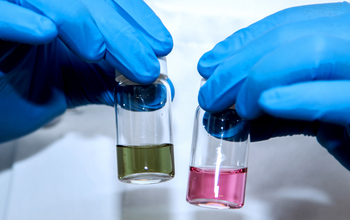Multimedia Gallery
Differently shaped gold nanoparticles
University of Minnesota professor Abdennour Abbas and his research team have been conducting basic research on the interactions between gold nanoparticles and cell surfaces to create novel sensors. Differently shaped gold nanoparticles like the flat triangular gold (green solution on left) and spherical gold (red-pink solution on right) not only appear different, they can have very unique interactions with cells that can be exploited to create novel reactions that yield detectable signals like color changes or glowing reactions.
More about this image
Researchers from the University of Minnesota (UMN) have developed a method to screen and identify harmful or antibiotic-resistant bacteria within one hour using a portable luminometer. Traditional diagnostic methods often require complex equipment and lab work that can take days. The new method uses chemiluminescence, or the emission of light during a chemical reaction. It was developed with the food industry in mind and could also be used in health care settings.
In a published study, researchers from the College of Food, Agricultural and Natural Resource Sciences and the College of Science and Engineering at UMN demonstrated the new technology by analyzing surface swabs and urine samples for the presence of small concentrations of methicillin-resistant Staphylococcus aureus (MRSA), a bacteria that causes more than 11,000 deaths in the U.S. every year.
To screen for microorganisms, green gold in the form of triangular nanoplates was combined with a reducing agent and luminol. This caused a strong chemiluminescent reaction that was stable for as long as 10 minutes. When researchers introduced MRSA and other microorganisms into the combination, they consumed the gold nanoplates, causing the chemiluminescent intensity to decrease proportionally to the microbial concentration. This indicated a presence of microorganisms.
"Rapid microbial detection in less than two hours is not only vital to prevent food poisoning, but also to fight antimicrobial resistance by helping physicians make informed decisions before prescribing antibiotics," said Abdennour Abbas, a professor in the Department of Bioproducts and Biosystems Engineering, who directed the research. "More work is needed to apply this technology to more complex samples such as food and crops, but we’re hopeful that progress will continue in this area."
The research was supported in part by the National Science Foundation (grant CBET 16-05191).
Read more in the UC-Berkeley news story Research Brief: UMN researchers use green gold to rapidly detect and identify harmful bacteria. (Date image taken: 2018; date originally posted to NSF Multimedia Gallery: Jan. 31, 2019)
Credit: Nkauj Vang, University of Minnesota
Images and other media in the National Science Foundation Multimedia Gallery are available for use in print and electronic material by NSF employees, members of the media, university staff, teachers and the general public. All media in the gallery are intended for personal, educational and nonprofit/non-commercial use only.
Images credited to the National Science Foundation, a federal agency, are in the public domain. The images were created by employees of the United States Government as part of their official duties or prepared by contractors as "works for hire" for NSF. You may freely use NSF-credited images and, at your discretion, credit NSF with a "Courtesy: National Science Foundation" notation.
Additional information about general usage can be found in Conditions.
Also Available:
Download the high-resolution JPG version of the image. (4.7 MB)
Use your mouse to right-click (Mac users may need to Ctrl-click) the link above and choose the option that will save the file or target to your computer.

